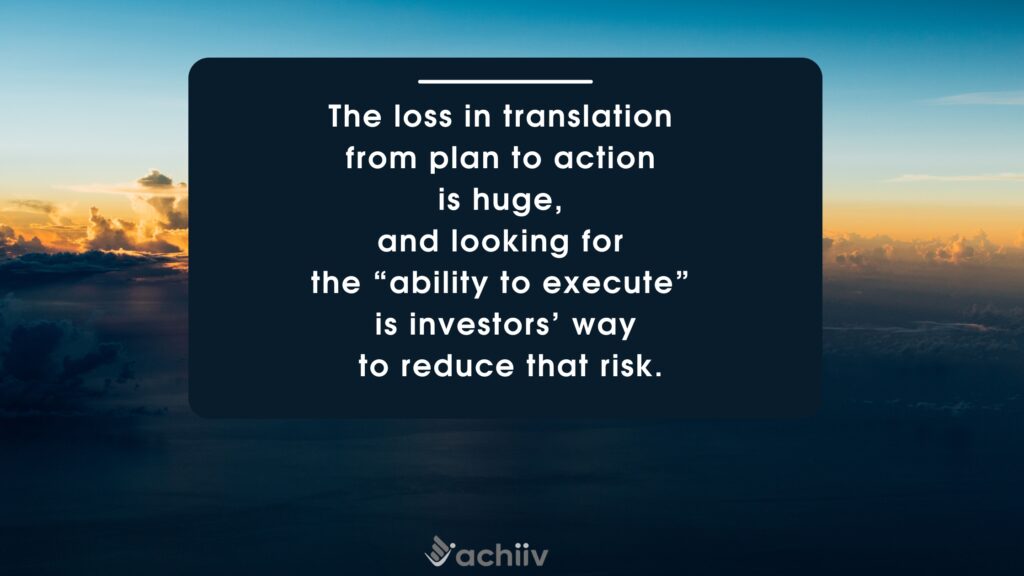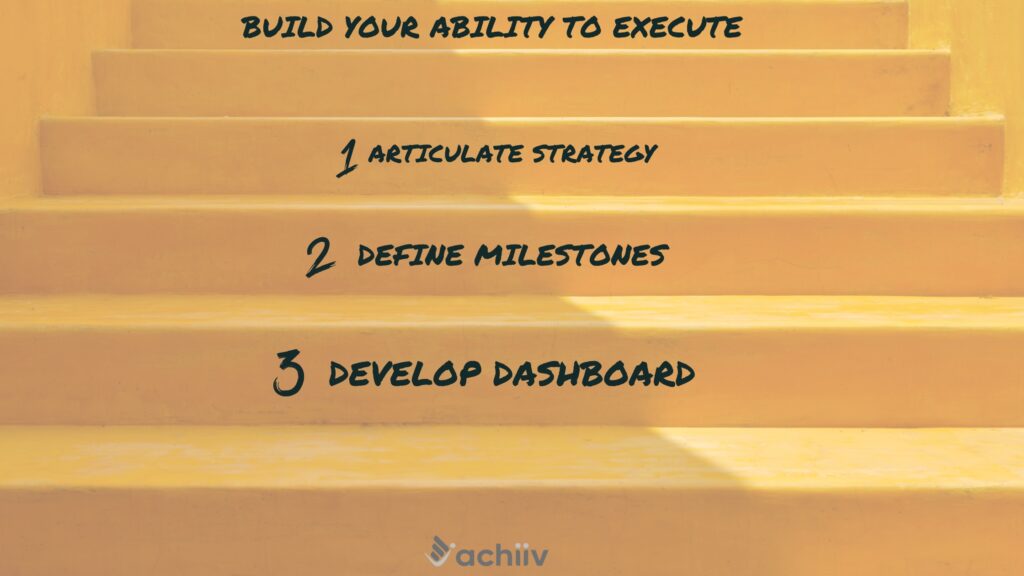When I was working in Corporate America, one of the tropes was that to get promoted you had to demonstrate “leadership ability”. But no one told you how to get it, or even what it was. I’m often reminded of this when investors keep talking about how important it is for founders to demonstrate the “ability to execute”. When you’re the founder, this isn’t particularly helpful. What does it mean? How do you get it?
Early on, investors have few tangible markers to evaluate your startup. There are the usual suspects: big market, breakthrough product, compelling go-to-market strategy. But as any experienced investor can tell you, there are many startups that had a flawless pitch and a plan that dazzled on paper but bit the dust after being funded. The risk of loss in translation is huge, and looking for the “ability to execute” is investors’ way to reduce that risk.
Why Execution is Everything
Execution is always important. But in a startup, it outweighs almost all other factors except market opportunity because of:
- Extreme uncertainty: With every startup, investors know big changes will happen, but nobody can predict what they are or what they’ll impact. A pandemic hits, capital dries up because a bank fails, or trade policy changes dramatically. So investors need to feel confident that you will understand and respond quickly to these big shifts.
- Resource scarcity: As a founder, you’re always operating on less than you need: in time, money, and resources. So every action taken, hour invested, relationship built and dollar spent must provide outsize returns in more information, access to resources or opportunity. Without this discipline, you’ll run out of gas quickly.
- Data paucity: When you’re building a “new to world” business, you have no data or history to fall back on. You must be able to operate with scant information, and continue to make bets. Investors want to know how you’ll use this extreme paucity of data to steer your startup in dangerous waters.
To mitigate these risks, investors see one thing as the best insurance policy for their investment: your ability to execute.
The Three Building Blocks of The “Ability to Execute”
To convince them that you have this elusive quality they want, you need to build three distinct skills:

Setting Strategy and Direction
A well-respected academic once wrote that there are at least ten different meanings for the word “strategy”, as it relates to business. But investors don’t care about some consultant-style document or big words when it comes to your strategy. They want to know if you can:
- Choose your market: Two startups with the exact same product can play in very different markets. A startup making AI-enabled transcription, for example, can serve the legal market, or help influencers create content. Depending on that choice, they’ll do everything differently: from product design and pricing to customer support. As a founder, you must be able to articulate your choice of market and back it up with a convincing argument for why it makes sense for you.
- Understand the most powerful decision: Of the hundreds of decisions you’ll have to make, a few will make or break your startup. But the ones that have the most long term impact are the many choices you’ll say ‘no’ to, regardless of how tempting they appear: customers you won’t pursue, features you won’t build, channels you won’t use. Demonstrate that you can hold strong to the no’s to give the few “yeses” your best shot.
- Put the puzzle pieces together: How well will this customer segment work with that channel? How will your pricing fit their needs and budget constraints? How much money will this make? These are the questions you need to understand and resolve so the playbook you put together gives your startup the best shot at growth.
Getting Stuff Done
You have a great plan to sign up your first paid pilot but haven’t made many prospect calls. You have follow up questions from investors but take forever to get back. There are issues with the product prototype but the technicians are still waiting for your input three weeks later.
Investors know that you’re packing 24 hours’ worth of work into each day. But they still expect you to be able to prioritize, focus and get things done. This also means you know what to let slide, as much as you hate leaving things undone. And knowing to delegate tasks that someone else may not do as well as you, but can still get them done.
To prove your ability to get it done, show them you can:
- Prioritize the 2-3 most critical milestones you need to achieve in the next 3-6 months
- Flesh out the granular steps to get them completed
- Demonstrate the day-to-day, week-to-week discipline needed to ignore distractions until they’re achieved.
Navigating by Numbers
Here’s a story I love: In late spring of 1982, a routine British Airways flight enroute from Malaysia flew into a cloud of volcanic ash thrown up by the eruption of Indonesian volcano Mount Gallanggung. All four engines shut down, and the cockpit windows became opaque as the cabin filled with smoke, plunging the pilots into complete darkness.
Miraculously, the crew steered the plane to Jakarta for an emergency landing, essentially flying an inoperative craft.
Then the landing equipment failed.
Against all odds, they managed an injury-free landing, relying on the first officer’s skilled reading of the only component of the system that still worked.
The ability to know what numbers to read, where to get them, and how to use them to navigate are just as important to your ability to execute as you fly blind in an uncertain market and startup environment with few “visual” cues to guide you.
Here are a few powerful places to start building this muscle:
- Cause and effect chains: Do you have a strong understanding of the 5-7 factors that will have big impacts on downstream outcomes you care about? For example, how does hiring one more salesperson translate into sales calls, qualified leads, and eventually revenue?
- Relationship rules-of-thumb: These are called heuristics or mental shortcuts. Every business has critical relationships that are stable at least near-term. For example, every 10% increase in material costs might reduce your margin by 25%. Or for every doubling in sales, you might need to hire “x” more customer service people.
- The vital few: The human mind is limited in being able to handle only 5-7 pieces of information at a time. As the leader, you should have a strong grasp of a small set of metrics that give you an instant read of your startup at any time: Leading indicators, for example, number of leads in the pipeline; operating metrics, for example, capacity utilization of your platform, and financial metrics, for example, revenue, cash flow and costs.
Even if you start at ground zero, using these three starting points will help you quickly master the core of what drives your startup’s progress.

Putting it Into Action
So you have the playbook. Where do you start? How do you proceed?
Here are four simple steps to take to supercharge your ability to execute:
- Articulate your startup strategy in four bullet points: The market you’re playing in, the core value, your product and the channel
- Identify the critical three milestones you need to achieve in the next 6-12 months. List out the sub-steps you need to take for each, assigning target dates and resources
- Build the end-to-end chain of tasks and outcomes for sales, product development, and cash inflow. For example, you run social media ads to get leads for a webinar that salespeople will then use to qualify and sell to attendees. Identify the most impactful lever in each chain.
- Create your simple dashboard of the vital few metrics covering leading indicators, operational metrics and financials.
With this one-page navigational guide in place, when surprises hit, you’ll be well-positioned to assure investors with the same sang-froid that Capt. Eric Moody demonstrated on that fateful night:
“Ladies and gentlemen, this is your captain speaking. We have a small problem. All four engines have stopped. We are doing our damnedest to get them going again. I trust you are not in too much distress.”
Can you pull it off?







